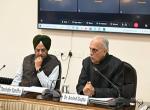Vice Admiral (Retd) Anup Singh, PVSM, AVSM, NM, former Commander in Chief, Eastern Naval Command, delivered a talk on 'Economic Potential of India's Maritime Domain & Security Implications', on 21st March 2014 at the Vivekananda International Foundation under its monthly series of talks given by eminent personalities, Vimarsha.
In his address, Vice-Admiral Singh said the maritime riches of our ocean environment have been neglected for a long time.
“Most Indians just don’t know how rich this piece of geography is! India dominates the Indian Ocean as if it has physically configured its peninsular jut, disturbing the symmetry of the North Indian Ocean – as if to oversee all activities in this water body. The economic and geopolitical advantage that accrues to India because of her location is enormous”, he said.
He highlighted the fact that the country has a coastline of 7516 km, can boast of 13 major and 187 minor and intermediate ports; a huge reservoir of fish and minerals; and possess the benefit of a peninsula that provides invaluable opportunities for location of strategic industries apart from uninterrupted access to the world.
Singh pointed out that maritime countries are naturally blessed. Historically, maritime nations have always had most of their populations and most of their industrialization established along the coast. Today, almost 50% of the world’s population is known to have settled within a belt of 150 km of the coastline because all economic development traditionally takes place close to the shore. The sea, therefore, is a great asset and we should never lose sight of the fact that we are ‘naturally blessed’, he said.
India’s Exclusive Economic Zone (EEZ), he said, extends to 200 NM but is set to become 350 NM in some areas, once the new submissions on the Continental Shelf are accepted by the UN appointed body. With that, India’s EEZ would become almost 2.54 million square km instead of the current 2.02 million square km. And that means we are multiplying the offshore domain for extracting fish, minerals, gas, oil - whatever one wants from the sea! There is abundance of fish, which is not fully harvested, and an abundance of riches in the subsoil including mineral resources which are waiting to be tapped.
Referring to the 13 major ports in India, he said they are the largest ports in this part of the world in so far as real estate is concerned. But when compared to any port anywhere in the world, the throughput of these ports is embarrassingly low. Private ports on the other hand are doing wonderfully well. Despite their small estates, many private ports or leased ports are doing much better than the major ports. What ails our major ports is archaic systems of evacuation, logistics, mechanisation and of course the red tape we are so used to! What is needed is the “single window” and commerce friendly model in major ports, he said.
Moving to India’s merchant fleet, the Vice-Admiral lamented that India has a total tonnage of just about 10 million tons, with a total number of 1041 ships. But, of these, only about 340 ships are involved in overseas trade. This is a poor commentary on a large maritime nation like India which should have a fleet large enough to be able to carry all its trade, at all times – in peace, or crisis.
The story about shipbuilding is similarly gloomy. “We have only 27 shipyards in this country and none of them is capable of building large ships – except the Cochin Shipyard. And that shipyard does not receive orders for large ships even from Indian Companies who prefer foreign builders like China and Korea. Shipbuilding is a strategic industry and enables a country to become self-reliant as well as a “revenue earner”. The reasons for our dormancy are lack of encouragement and high taxation regimes by the Government,” he asserted.
Looking at Inland Waterways, officially we have a total of 4400 km of Inland Waterways declared as “active channels”. However, hardly 0.1% of all domestic cargo moves through them. We lament that our rivers are very shallow. But the Missisipi and Ohio waterways of North America offer no more the 3.5 meters of depth. Yet, Americans transact 1.2 billion tons of cargo through inland water ways measuring 20,000 km. In our case, upto16,500 km of waterways were assessed to be useable but there is no point in developing them till the active channels themselves receive clientele. These are not being optimally utilised. The potential is enormous and can heavily economise domestic traffic apart from making it eco-friendly.
Talking about coastal shipping, he maintained that it remained largely neglected in India – primarily because we do not have specified coastal hubs or ports. Many people are unaware that heavy cargo can be most economically conveyed as complete pieces by coastal carriers, at much cheaper rates than as fragmented parcels by road or by rail. In so far as coastal shipping is concerned, a poor 7% of all domestic cargo, by volume, moves by this mode.
The coastal belt also offers abundant opportunities for tourism and renewable energy sources, Singh said adding, the opportunities in our maritime domain are huge and most of these lie untapped.
If all the opportunities and resources are fully exploited, India’s economy can leapfrog by orders of magnitude, and will also generate employment through development of ancillary industries supporting maritime activity along an enviable length of India’s coastline and a vast EEZ.
As with every opportunity, there have to be challenges in the maritime domain that one must ward against. The security imperatives of our geostrategic location, the huge reservoir of riches in the EEZ, and India’s territorial integrity, cannot be ignored. In this day and age, it is not just traditional threats but also nontraditional/asymmetric challenges that must be pre-empted and taken seriously.
Vice-Admiral Singh concluded by saying that the implications of both kinds of threats are an indisputable need to spruce up our maritime forces – including the Navy, Coast Guard, Marine Police, and the Customs’ Marine Wing. There is an imminent need to draw up a force-architecture for all these forces anew, and allocate requisite capital budgets for their transformation into potent forces.








